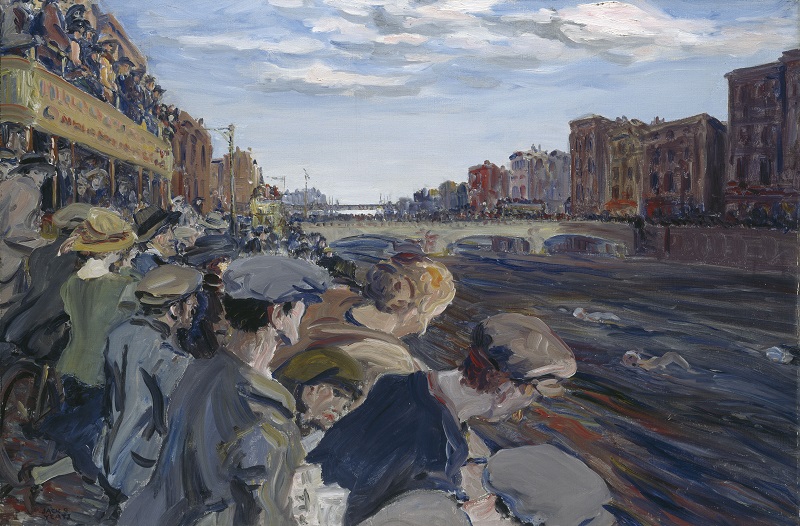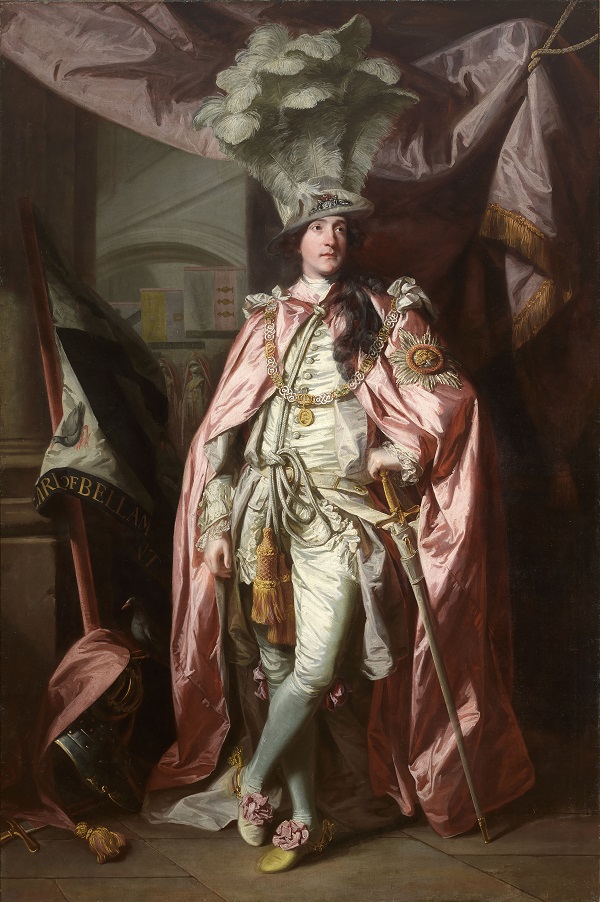National Gallery of Ireland review - bigger and better | reviews, news & interviews
National Gallery of Ireland review - bigger and better
National Gallery of Ireland review - bigger and better
Dublin celebrates the reopening of its refurbished art gallery with Vermeer

The marvellous National Gallery of Ireland, founded in the 1860s, has opened its doors to its brilliantly revamped, updated and expanded galleries. As a spectacular bonus in its opening summer, Vermeer and Masters of Genre Painting reposes in the enfilade of the newly re-done permanent galleries for temporary exhibitions.
After half a dozen years effectively closed for refurbishment, the new National Gallery of Ireland joins a roster of other modernised and expanded institutions. Just a year ago the Switch House opened at Tate Modern, and at the end of June, the V&A will open its massive new entrance, new public spaces and temporary exhibition gallery, while the National Portrait Gallery has announced plans to expand and effect a total re-hang by 2022. In this context, the NGI – in a country of 4.5 million – punches well above its weight, with a big community, education and events programme, its excellent café and its general buzz.
The statistics are awesome, with four wings dating from the 1860s to the 21st century, 15 different levels and new, more accessible entrances. Optimum viewing conditions have been achieved by careful navigation of the conservation issues, in order to upgrade to the best display conditions including much natural light. Eighty per cent of its galleries have been shut and have now emerged with a new chronological hang which no longer restricts schools of art geographically but demonstrates ever more clearly a zeitgeist that transcends boundaries.
Of the 650 or so works on view, two thirds have been restored. It is a telling collection of European art dating from the 14th century onwards, succinct and replete with masterpieces familiar and unfamiliar. For the visitor from outside Ireland the highly unusual aspect is their choice selection of Irish art (pictured above: Jack B Yeats, The Liffey Swim, 1923). There is a staggeringly over-the-top painting by the Cork-born Daniel Maclise (1806-1870), The Marriage of Strongbow and Aoife, dominating the Shaw gallery with its teeming crowd of warriors and celebrants of a 12th century political alliance between the Normans and the Irish, originally devised as a decoration for Parliament. It's Victoriana historical mishmash at its most hilariously beguiling.
Most of the artists, except perhaps Jack Yeats, who has a dedicated gallery, are not known in an international context. Those that are well known in the UK – Orpen and Lavery for example – had London careers. In a clever homage to Velazquez, Sir John Lavery’s superb period piece depicts Lady Lavery and her two daughters in her husband’s studio; Hazel was a renowned beauty and her portrait graced Irish banknotes until the arrival of the euro. The intensive look at Irish art includes a first-floor gallery dedicated to 20th and 21st Century Irish portraiture: several views of Seamus Heaney for example, and an affecting portrayal of Brian Friel.
 The chronological sweep of Irish material is on the ground floor, including an affecting collection of 20th century stained glass, an art at which the Irish excelled. The international plums on the upper floors entice the visitor to explore
The chronological sweep of Irish material is on the ground floor, including an affecting collection of 20th century stained glass, an art at which the Irish excelled. The international plums on the upper floors entice the visitor to explore
further (it is often surprising how difficult it is to get people to leave the ground floor). Here are Rembrandt, Velazquez, Rubens, Bellotto, Chardin, to name but a few. And some real surprises to find housed in Dublin: Raeburn’s masterpiece Sir John and Lady Clerk of Penicuik, 1790, on a large scale but curiously informal in its glimpse of marital affection, not to mention the swagger portrait to end all swagger portraits, Joshua Reynolds’ Charles Coote, 1st Earl of Belmont, 1773-74 (pictured right), dominating the end wall of the Dargan Wing Grand Gallery. Brilliant and varied wall colours, ranging from bold reds and blues to exquisite greys, provide a fine foil for the paintings as well as a subliminal rhythm for the visitor’s journey. These are galleries where it is both easy and pleasurable to see the art, which may seem such an obvious thing to say but which surprisingly few institutions manage with such understated elegance and subtle panache.
It is a brilliant coup to open with the thrilling exhibition of some 60 paintings from the Dutch Golden Age, centred on the 10 Vermeers (almost a third of his surviving work) including the NGI’s own Woman Writing a Letter with her Maid, c1670-71 (pictured below left). Beautifully displayed against dark blue walls, this is a show with a difference: a genuine piece of detective work attempting to show the ways artists looked at each other’s work – sometimes in terms of rivalry – in order to draw inspiration.
 There is not much documentation as to who saw what when, but the curators treat the paintings as visual evidence, based on chronology and known acquaintance, reminding us too that Holland was a small country in which even centuries ago it was easy to travel. Poses and subjects were often in common: all on view here are interiors with people, almost exclusively those of the upper bourgeoisie, often with their servants: women and their maids, but sometimes working people on their own.
There is not much documentation as to who saw what when, but the curators treat the paintings as visual evidence, based on chronology and known acquaintance, reminding us too that Holland was a small country in which even centuries ago it was easy to travel. Poses and subjects were often in common: all on view here are interiors with people, almost exclusively those of the upper bourgeoisie, often with their servants: women and their maids, but sometimes working people on their own.
Music-making is a recurrent theme, as is the writing of letters, explored in a rather wonderful category called "Corresponding Love", and pets. Many a painting has a dog, but Vermeer eschewed, it becomes readily apparent, both children and animals, unlike most of his peers. From Gerrit Dou to Caspar Netscher, Gerard ter Borch to Pieter de Hooch, many of these charming and technically expert artists were better known and more successful in their day than Vermeer. And however realistic these scenes may appear to be, it is made apparent how intelligently the compositions were inventions, artistically contrived. And Vermeer shines, the glowing luminosity of his paintings even more aglow in their subtle complications than those of his peers. This may be one of the most enjoyable immersions in art history this decade.
- Vermeer and the Masters of Genre Painting: Inspiration and Rivalry at the National Gallery of Ireland, Dublin until 17 September
- Read more visual arts reviews on theartsdesk
rating
Explore topics
Share this article
The future of Arts Journalism
You can stop theartsdesk.com closing!
We urgently need financing to survive. Our fundraising drive has thus far raised £49,000 but we need to reach £100,000 or we will be forced to close. Please contribute here: https://gofund.me/c3f6033d
And if you can forward this information to anyone who might assist, we’d be grateful.

Subscribe to theartsdesk.com
Thank you for continuing to read our work on theartsdesk.com. For unlimited access to every article in its entirety, including our archive of more than 15,000 pieces, we're asking for £5 per month or £40 per year. We feel it's a very good deal, and hope you do too.
To take a subscription now simply click here.
And if you're looking for that extra gift for a friend or family member, why not treat them to a theartsdesk.com gift subscription?
more Visual arts
 'We are bowled over!' Thank you for your messages of love and support
Much-appreciated words of commendation from readers and the cultural community
'We are bowled over!' Thank you for your messages of love and support
Much-appreciated words of commendation from readers and the cultural community
 Folkestone Triennial 2025 - landscape, seascape, art lovers' escape
Locally rooted festival brings home many but not all global concerns
Folkestone Triennial 2025 - landscape, seascape, art lovers' escape
Locally rooted festival brings home many but not all global concerns
 Sir Brian Clarke (1953-2025) - a personal tribute
Remembering an artist with a gift for the transcendent
Sir Brian Clarke (1953-2025) - a personal tribute
Remembering an artist with a gift for the transcendent
 Emily Kam Kngwarray, Tate Modern review - glimpses of another world
Pictures that are an affirmation of belonging
Emily Kam Kngwarray, Tate Modern review - glimpses of another world
Pictures that are an affirmation of belonging
 Kiefer / Van Gogh, Royal Academy review - a pairing of opposites
Small scale intensity meets large scale melodrama
Kiefer / Van Gogh, Royal Academy review - a pairing of opposites
Small scale intensity meets large scale melodrama
 Jenny Saville: The Anatomy of Painting, National Portrait Gallery review - a protégé losing her way
A brilliant painter in search of a worthwhile subject
Jenny Saville: The Anatomy of Painting, National Portrait Gallery review - a protégé losing her way
A brilliant painter in search of a worthwhile subject
 Abstract Erotic, Courtauld Gallery review - sculpture that is sensuous, funny and subversive
Testing the boundaries of good taste, and winning
Abstract Erotic, Courtauld Gallery review - sculpture that is sensuous, funny and subversive
Testing the boundaries of good taste, and winning
 Edward Burra, Tate Britain review - watercolour made mainstream
Social satire with a nasty bite
Edward Burra, Tate Britain review - watercolour made mainstream
Social satire with a nasty bite
 Ithell Colquhoun, Tate Britain review - revelations of a weird and wonderful world
Emanations from the unconscious
Ithell Colquhoun, Tate Britain review - revelations of a weird and wonderful world
Emanations from the unconscious
 Rachel Jones: Gated Canyons, Dulwich Picture Gallery review - teeth with a real bite
Mouths have never looked so good
Rachel Jones: Gated Canyons, Dulwich Picture Gallery review - teeth with a real bite
Mouths have never looked so good
 Yoshitomo Nara, Hayward Gallery review - sickeningly cute kids
How to make millions out of kitsch
Yoshitomo Nara, Hayward Gallery review - sickeningly cute kids
How to make millions out of kitsch
 Hamad Butt: Apprehensions, Whitechapel Gallery review - cool, calm and potentially lethal
The YBA who didn’t have time to become a household name
Hamad Butt: Apprehensions, Whitechapel Gallery review - cool, calm and potentially lethal
The YBA who didn’t have time to become a household name

Add comment